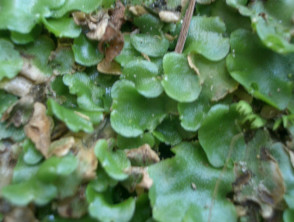| Common name: | Liverworts belong to a group of plants known as the Bryophytes which are usually green, usually small, and are amongst the simplest of land-dwelling plants (a few are aquatic). The name ‘liverwort’ derives from the Anglo-Saxon word ‘lifer’, meaning liver and ‘wyrt’, the word for plant. During the 16th century, it was commonly applied to the genus Marchantia, a flat, branching, ribbon-shaped plant the margins of which were claimed to resemble the lobes of a liver. |
| Botanical name: | The bryophyte comprise the mosses, liverworts and hornworts. There are about 25,000 different species of bryophytes |
| Family: | Hepaticea (liverworts) |
| Origin: | Liverworts have been found in fossils dating as far back as the Palaeozoic Era. They are believed to have shared a common ancestry with the green algae. There are approximately 8,500 species of liverworts. They are widely distributed, occurring from the arctic to the tropics. Although some grow in relatively dry places and a few are submerged aquatics, most liverworts occur in places where moisture is generally available, e.g., on damp soil or moist rotting logs, along shaded stream banks, on rocks in streams, or on wet rock outcroppings; a few even grow under saline conditions. |
| Description: | Liverworts lack some of the complex structures seen in other types of plant — they do not produce flowers or seeds, and most have no internal means for transporting water or nutrients. There are two broad types of liverwort, separated on the basis of their general structure: leafy liverworts, and the thallose liverworts. The thallose gametophytes are flat, membranous forms with even, slightly wavy, lobed or leafy margins. There is a great diversity in the shape of liverwort leaves; they may be undivided, variously lobed or divided into hair-like segments, or they may be folded into two lobes of unequal size with the smaller lobe situated atop or below the larger. |
| Uses: | Ecologically, bryophytes play a major role in maintaining an ecosystem's humidity level by their ability to absorb and retain water. Environmentally, they are often used as indicators of the habitat condition. Any change in water, soil and/or air quality, due to pollution or other factors, will have an impact on bryophyte growth. |
| Allergens: | Only liverworts with leaves, or Jungermaniales, appear to be sensitising. Liverworts grow on the bark of trees such as chestnuts, acacias, poplars, beech, and oak-trees. Contact is therefore most commonly seen in forestry workers and gardeners. The main allergic liverwort species are Frullania dilatata and Frullania tamarisci which are known to contain a number of sesquiterpene lactones. |
| Allergy: | Forestry workers may develop allergic contact dermatitis or airborne contact dermatitis, and photosensitivity. Occasional reports of vasculitis. |
| Cross reactions: | Laurel, other compositae plants. There are a number of reports of cross-sensitivity with Lichens spp, but these may represent simultaneous sensitisation as lichens and liverworts co-exist in the same environments. |
| Other information: | Since the Doctrine of Signatures, a popular concept at the time, proclaimed that God had bestowed upon each plant He had created a mark or sign that pointed to its medicinal value; the liverwort Marchantia with its imagined liver-shaped lobes was believed to be useful for the treatment of liver ailments. |
| Patch test: | Sesquiterpene lactone mix, compositae mix, specific species of liverworts. |
